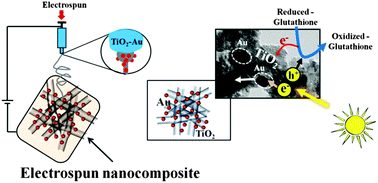Single-step electrospun TiO2–Au hybrid electrodes for high selectivity photoelectrocatalytic glutathione bioanalysis†
Abstract
Understanding the fundamentals of photoelectrocatalytic (PEC) biomolecular oxidation benefits the development of next-generation PEC biosensors. In this work, single-step electrospun titanium-di-oxide–gold (TiO2–Au) hybrid nanofibers (HNF) are reported as being a potential candidate for PEC glutathione (GSH) bioanalysis. The chemical environment of TiO2 and TiO2–Au HNFs were studied with X-ray photoelectron spectroscopy and found to have a strong electronic interaction between TiO2 and the Au nanoparticles (NPs). The PEC measurements revealed that the intramolecular backbone hydrogen bonding of GSH molecules predominantly contributes highly active Au–GSH bio-nano interfaces, which facilitate the PEC oxidation rate of GSH and thus enhance the photocurrent. Furthermore, the Au NPs present act as auxiliary electron transport channels resulting in enhanced charge collection at the external circuit. As a result, the TiO2–Au electrode generated a two-fold higher photocurrent density of ∼84.4 μA cm−2 in the presence of 0.5 mM GSH, where the pristine TiO2 NFs displayed only a negligible influence. Likewise, the TiO2–Au HNF electrode showed a higher sensitivity of 0.002 mM and a wide linear detection range between 0.022 mM and 0.7 mM, with a superior selectivity towards GSH bioanalysis over ascorbic acid and glucose at −0.33 V (versus silver/silver chloride) than that obtained with pristine TiO2. The implications of these findings towards the development of a next-generation PEC biosensor are discussed.


 Please wait while we load your content...
Please wait while we load your content...